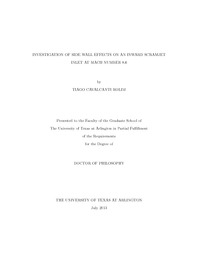| dc.description.abstract | Experimental and computational studies were conducted to evaluate the performance of a scramjet inlet as the side cowl length is changed. A slender inward turning inlet with a total length of 304.8 mm, a span of 50.8 mm with a top and a bottom compression ramp each at 11.54 deg and a compression ratio of 4.79 was used. The side cowl lengths were of 0, 50.8 and 76.2 mm. The UTA Hypersonic Shock Tunnel facility was used in the reflected mode to test the inlet model. The model was instrumented with nine piezoelectric pressure transducers, for static and total pressure measurements. A wedge was mounted at the rear of the inlet to accommodate a Pitot pressure rake. The driven tube was instrumented with three pressure transducers. Two of them were used to measure the incident shock wave speed, and a third one was used for stagnation pressure measurements during a test. Furthermore, a Pitot probe was installed below the model to measure the impact pressure on each run, this reading along with the driven sensor readings, allowed us for the calculation of freestream properties. During the experiments, nominal stagnation enthalpy of 0.67 MJ/kg and stagnation pressure of 3.67 MPa were achieved. Freestream conditions were Mach number 8.6 and Reynolds number of 1.94 million per m. Test times were 300-500 μs. Numerical simulations using RANS with the Wilcox K-ω turbulence model were performed using ANSYS Fluent. The results from the static pressure measurements presented a good agreement with CFD predictions. Moreover, the uniformity at the inlet exit was achieved within experimental accuracy. The experiments showed that the cowl length has a pronounced effect on the inlet pressure distribution but a minor effect on the exit flow Mach number. The numerical results confirmed these trends and showed that a complex flow structure is formed in the cowl-ramp corners; a non-uniform transverse shock structure was found to be related to the cowl leading edge position. | en_US |

